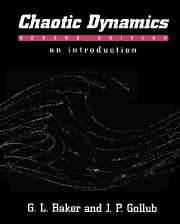Book contents
- Frontmatter
- Contents
- Preface
- Acknowledgments
- CHAPTER ONE Introduction
- CHAPTER TWO Some helpful tools
- CHAPTER THREE Visualization of the pendulum's dynamics
- CHAPTER FOUR Toward an understanding of chaos
- CHAPTER FIVE The characterization of chaotic attractors
- CHAPTER SIX Experimental characterization, prediction, and modification of chaotic states
- CHAPTER SEVEN Chaos broadly applied
- Further reading
- Appendix A Numerical integration – Runge–Kutta method
- Appendix B Computer program listings
- Appendix C Solutions to selected problems
- References
- Index
- Diskette order information
CHAPTER SEVEN - Chaos broadly applied
Published online by Cambridge University Press: 05 June 2012
- Frontmatter
- Contents
- Preface
- Acknowledgments
- CHAPTER ONE Introduction
- CHAPTER TWO Some helpful tools
- CHAPTER THREE Visualization of the pendulum's dynamics
- CHAPTER FOUR Toward an understanding of chaos
- CHAPTER FIVE The characterization of chaotic attractors
- CHAPTER SIX Experimental characterization, prediction, and modification of chaotic states
- CHAPTER SEVEN Chaos broadly applied
- Further reading
- Appendix A Numerical integration – Runge–Kutta method
- Appendix B Computer program listings
- Appendix C Solutions to selected problems
- References
- Index
- Diskette order information
Summary
The primary physical example discussed up to this point is the driven pendulum, which provides an elementary pedagogical example of a chaotic system. Its behavior is extraordinarily complex. Varying the parameters leads to an intricate pattern of periodic and chaotic states with several types of transitions between them. In the chaotic regions, nearby orbits diverge exponentially from each other, with consequent long-term unpredictability. We have also discussed how a single experimental time series can be used to characterize chaotic states, to control them, or to achieve short-term predictability.
Chaos occurs widely in nature. In this chapter we briefly describe examples of chaotic behavior in lasers, chemical reactions, fluid dynamics, interfacial growth, and earthquake models. We emphasize the fact that natural systems are often spatially extended and therefore have intrinsically many degrees of freedom. Thus, their chaotic behavior may be more complicated than that of the pendulum and other systems with only a few degrees of freedom. Still, the main concepts of nonlinear dynamics continue to play a significant role in organizing our knowledge of spatially extended nonlinear systems. At the end of this final chapter, we consider the impact of our understanding of chaos on two major fields of theoretical physics: quantum mechanics and statistical mechanics.
Chaos in lasers
Since the early days of laser technology, instabilities in laser action have been apparent. That is, the light output need not be time-independent (Harrison and Biswas, 1986).
- Type
- Chapter
- Information
- Chaotic DynamicsAn Introduction, pp. 166 - 189Publisher: Cambridge University PressPrint publication year: 1996



